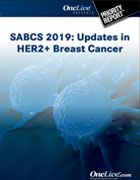Publication
Article
Priority Report
Further Data Demonstrate Equivalence for Subcutaneous, IV Formulations of Trastuzumab in HER2+ Breast Cancer
Author(s):
Subcutaneous trastuzumab with hyaluronidase-oysk in combination with intravenous pertuzumab and chemotherapy had a safety profile consistent with IV trastuzumab in first-line metastatic HER2-positive breast cancer treatment.
Sherko Kummel, MD, of Kliniken Essen-Mitte in Germany

Sherko Kümmel, MD
Subcutaneous (SC) trastuzumab with hyaluronidase-oysk (Herceptin Hylecta) in combination with intravenous (IV) pertuzumab (Perjeta) and chemotherapy had a safety profile consistent with IV trastuzumab as first-line treatment for metastatic HER2-positive breast cancer, according to results of a large single-arm phase IIIb trial.
Overall, about half of 412 patients had grade ≥3 adverse events (AEs), one fifth had AEs leading to drug withdrawal, and about a third had AEs leading to drug interruption. Among AEs to monitor, diarrhea, mucositis, and rash occurred most often. Aside from hematologic AEs, grade ≥3 AEs to monitor were uncommon. Investigator-reported AEs/grade ≥3 AEs also were infrequent.
An exploratory efficacy analysis also yielded results consistent with historical data from the landmark CLEOPATRA trial, Sherko Kümmel, MD, of Kliniken Essen-Mitte in Germany, reported at the 2019 San Antonio Breast Cancer Symposium (SABCS).1,2
“The CLEOPATRA trial was practice changing and established IV pertuzumab plus IV trastuzumab with chemotherapy, followed by IV trastuzumab and chemotherapy, as standard of care for patients with HER2-overexpressing metastatic breast cancer,”. Kümmel told OncLive. “This is the second trial of that treatment, and even though it is not a randomized trial, it affirms the efficacy of the CLEOPATRA trial, in terms of PFS (progression-free survival) and OS (overall survival).”
“These are the first data where we have both the efficacy and safety from the trastuzumab subcutaneous formulation together with pertuzumab IV,” he added.
Early studies of SC trastuzumab demonstrated noninferiority to IV trastuzumab with respect to pathologic complete response in the breast and serum trough concentration at pre-dose cycle 8.3 Subsequent studies confirmed noninferiority with respect to event-free survival, OS, and safety.4-6
The SC formulation offers the potential to reduce treatment burden for patients and increased satisfaction health care professionals, Dr. Kummel noted. Those qualities were confirmed in studies of early and metastatic HER2-positive breast cancer.7-9
Dr. Kummel presented results from the primary and final analysis of the MetaPHER study, the largest trial conducted to date to evaluate the safety and tolerability of first-line SC trastuzumab plus IV pertuzumab and docetaxel in patients with advanced (locally recurrent or metastatic) HER2-positive breast cancer. All patients received SC trastuzumab at a fixed dose of 600 mg/5mL every 3 weeks, IV pertuzumab with an 840-mg loading dose followed by 420-mg maintenance doses every 3 weeks, and 6 or more doses of IV docetaxel at 75 mg/m2 every 3 weeks. Treatment continued until disease progression or development of unacceptable toxicity.
The primary objective was to evaluate the safety and tolerability of the regimen. Efficacy (objective response, investigator-assessed PFS and OS) was a secondary objective.
The patients had a median age of 56 years, 62.4% were postmenopausal, 97.3% had metastatic disease, 70.4% were hormone-receptor positive, and 52.7% had been treated previously, including trastuzumab (31.8%), a taxane (32.8%), and hormonal therapy (33.7%).
Median treatment exposure was 22.0 cycles of SC trastuzumab, 21.5 cycles of IV pertuzumab, and six cycles of docetaxel.
Overall, 98.5% of patients had one or more AEs, 53.6% had grade ≥3 AEs, and 26% had serious AEs. Nine patients had fatal AEs, 96.8% of AEs were considered treatment relate, 21% had AEs leading to withdrawal, and 35.7% had AEs leading to drug interruption.
Diarrhea was the most commonly reported AE (63.3%), followed by mucositis (36.9%), rash (34.7%), leukopenia (26.9%), and neutropenia (18.2%). Grade ≥3 AEs were led by leukopenia (20.4%), neutropenia (12.6%), febrile neutropenia (8.5%), and diarrhea (5.1%). The frequency of investigator-reported administration-related and injection-site reactions of 21.1% (5.1% SC trastuzumab, 5.3% IV pertuzumab, and 11.7% docetaxel). Grade ≥3 investigator-reported AEs consisted of one case involving IV pertuzumab and four involving docetaxel.
Three grade ≥3 cardiac AEs occurred, as well as one serious AE suggestive of heart failure. Dr. Kummel reported a 10.1% of evaluable patients had at least a 10% reduction in left ventricular ejection fraction or a decrease to <50%. Two patients had symptomatic LV dysfunction. The decrease in LVEF resolved in most cases.
Investigator assessed median PFS was 18.7 months. OS at 12 and 24 months was 92.9% and 81.1%, respectively.
Analysis of objective response in 336 patients showed an overall response rate of 75.6%, including complete responses in 12.5%. An additional 16.4% of patients had stable disease, resulting in a clinical benefit rate of 92%.
References
- Final analysis of the Phase IIIb, multicenter, open-label, single-arm MetaPHER study. Presented at: 2019 San Antonio Breast Cancer Symposium; December 10-14, 2019; San Antonio, TX. Abstract P1-18-05.
- Baselga J, Cortés J, Kim SB, et al; Cleopatra Study Group. Pertuzumab plus trastuzumab plus docetaxel for metastatic breast cancer. N Engl J Med. 2012;366(2):109-119. doi: 10.1056/NEJMoa1113216.
- Ismael G, Hegg R, Muehlbauer S, et al. Subcutaneous versus intravenous administration of (neo)adjuvant trastuzumab in patients with HER2-positive, clinical stage I-III breast cancer (HannaH study): a phase 3, open-label, multicentre, randomised trial. Lancet Oncol. 2012;13(9):869-878. doi: 10.1016/S1470-2045(12)70329-7.
- Jackisch C, Kim SB, Semiglazov V, et al. Subcutaneous versus intravenous formulation of trastuzumab for HER2-positive early breast cancer: updated results from the phase III HannaH study. Ann Oncol. 2015;26(2):320-325. doi: 10.1093/annonc/mdu524.
- Jackisch C, Hegg R, Stroyakovskiy D, et al. HannaH phase III randomised study: association of total pathological complete response with event-free survival in HER2-positive early breast cancer treated with neoadjuvant-adjuvant trastuzumab after 2 years of treatment-free follow-up. Eur J Cancer. 2016;62:62-75. doi: 10.1016/j.ejca.2016.03.087.
- Jackisch C, Stroyakovskiy D, Pivot X, et al. Subcutaneous vs intravenous trastuzumab for patients with ERBB2-positive early breast cancer: final analysis of the HannaH phase 3 randomized clinical trial. JAMA Oncol. 2019;5(5):e190339. doi: 10.1001/jamaoncol.2019.0339.
- Pivot X, Gligorov J, Müller V, et al. Preference for subcutaneous or intravenous administration of trastuzumab in patients with HER2-positive early breast cancer (PrefHer): an open-label randomised study. Lancet Oncol. 2013;14(10):962-970. doi: 10.1016/S1470-2045(13)70383-8.
- Pivot X, Gligorov J, Müller V, et al. Patients' preferences for subcutaneous trastuzumab versus conventional intravenous infusion for the adjuvant treatment of HER2-positive early breast cancer: final analysis of 488 patients in the international, randomized, two-cohort PrefHer study. Ann Oncol. 2014;25(10):1979-1987. doi: 10.1093/annonc/mdu364.
- Pivot X, Spano JP, Espie M, et al. Patients' preference of trastuzumab administration (subcutaneous versus intravenous) in HER2-positive metastatic breast cancer: Results of the randomised MetaspHer study. Eur J Cancer. 2017;82:230-236. doi: 10.1016/j.ejca.2017.05.009.










